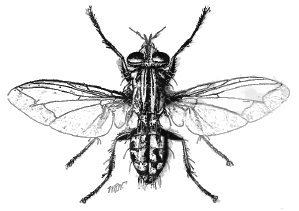description of its habits, frequents the fields in Kansas where grasshoppers are abundant. Individuals of this fly, according to Doctor Kelly's account, are often seen

Fig. 10. A fly whose larvae are parasitic on grasshoppers, Sarcophaga kellyi. (Much enlarged)
to dart after grasshoppers on the wing and strike against them. The stricken insect at once drops to the ground. Examination reveals no physical injury to the victim, but on a close inspection there may be found adhering to the under surface of a wing several tiny, soft, white bodies. Poison pills? Pellets of infection? Nothing so ordinary. The things are alive, they creep along the foids of the wing toward its base—they are, in short, young flies born at the instant the body of the mother fly struck the wing of the grasshopper. But a
young fly would never be recognized as the offspring of its parent; it is a wormlike creature, or maggot, having neither wings nor legs and capable of moving only by extending and contracting its sort, flexible body (Fig. 182 D).
In form, the young Sarcophaga kellyi does not differ particularly from the maggots of other kinds of flies, but the Sarcophaga flies in general differ from most other insects in that their eggs are hatched within the bodies of the females, and these flies, therefore, give birth to young maggots instead of iaying eggs. The female of Sarcophaga kellyi, then, when she launches her attack on the flying grasshopper, is munitioned with a load of young maggots ready to be discharged and stuck by the moisture of their

